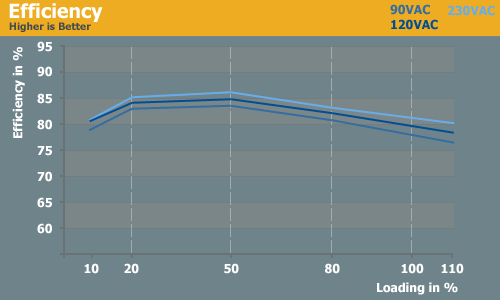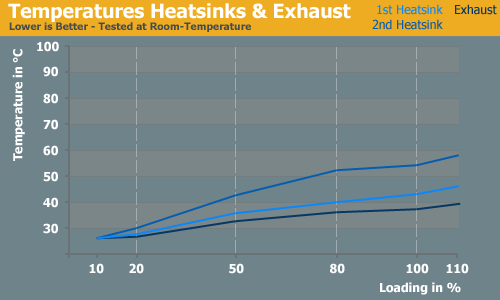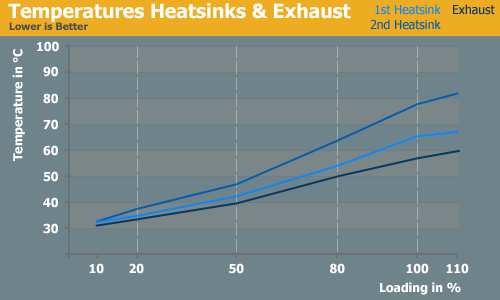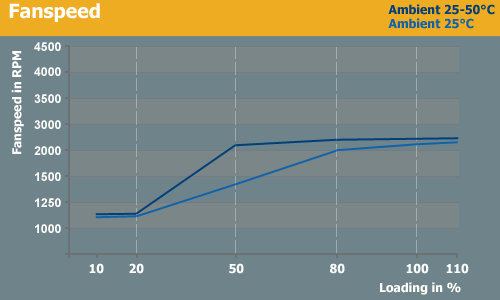Ultra High-End PSU Roundup
by Christoph Katzer on October 22, 2007 6:00 AM EST- Posted in
- Cases/Cooling/PSUs
CM 1250W Efficiency, Temperatures, Fan Speed and Acoustics

The efficiency is very good, and even with lower inputs of just 90VAC it generally stays above 80% (except at maximum load). With 86% it reached its highest point with 230VAC and 620W of load. Overall this is a very good performance by the Real Power Pro.


Even though the heat sinks are quite massive the temperature still reaches up to 81°C, which is very high. The difference here is that all components of the secondary stage are connected to the one heat sink; the PCP&C Turbo Cool has several components with their own small heat sink and therefore these weren't counted into the main heat sink temperatures. Both graphs reach slightly above 30°C over the ambient temperature which means if you have a cooler environment you will have a cooler power supply. This is different from what we have seen with other power supplies where ambient temperature plays less of a role.


The graphs of the fan speed and the acoustics speak a clear language which may not be as visible on the other graphs. With a hot environment and a half load of 600W, the fan is already at its highest speed. Under room temperature the fan slowly increases speed until it just reaches the fastest RPM with full load applied. The produced noise is of course clearly auditable since more than 1000W need to be cooled down in some way. It's simply impossible to have a quiet (let alone silent) 1000W+ power supply fit into a reasonably small chassis.

The efficiency is very good, and even with lower inputs of just 90VAC it generally stays above 80% (except at maximum load). With 86% it reached its highest point with 230VAC and 620W of load. Overall this is a very good performance by the Real Power Pro.


Even though the heat sinks are quite massive the temperature still reaches up to 81°C, which is very high. The difference here is that all components of the secondary stage are connected to the one heat sink; the PCP&C Turbo Cool has several components with their own small heat sink and therefore these weren't counted into the main heat sink temperatures. Both graphs reach slightly above 30°C over the ambient temperature which means if you have a cooler environment you will have a cooler power supply. This is different from what we have seen with other power supplies where ambient temperature plays less of a role.


The graphs of the fan speed and the acoustics speak a clear language which may not be as visible on the other graphs. With a hot environment and a half load of 600W, the fan is already at its highest speed. Under room temperature the fan slowly increases speed until it just reaches the fastest RPM with full load applied. The produced noise is of course clearly auditable since more than 1000W need to be cooled down in some way. It's simply impossible to have a quiet (let alone silent) 1000W+ power supply fit into a reasonably small chassis.










27 Comments
View All Comments
redly1 - Monday, October 22, 2007 - link
I'm just trying to imagine the flames that ensue when something goes bad on the motherboard.Anyone ever burn up a classic Athlon by forgetting to put the heatsink on? Imagine doing that with a 1.3kW supply? Yikes
billa16 - Tuesday, October 23, 2007 - link
I did that on a k7@950. I was trying to oc it(hardmod with a pencil). Nothing happend the first 2 times(just a few secs). After that it's stopped working. No sparks/flames and stuff like that. Don't belive anything U read/see on the internet.This type of power supply's have protections. If something is damaged so bad that would cause flames the protection kicks in. The worst fire scenario with this type of PSU will be a flash when the fuse burns out.
Sorry for my poor english.
DigitalFreak - Monday, October 22, 2007 - link
Still amazes me how many people fall for the marketing hype...Traciatim - Monday, October 22, 2007 - link
Instead of just giving specs and doing an overview of the efficiency, why not design a machine that actually needs these over say a 600-700Watt PSU and show watt you would need to do do actually use one of these.I have a pretty small machine, and it regularly pulls 120Watts out of the wall, 200Watts if I Get everything ramped up. I'm also using a P4, not a Core2Duo so it's not going to be as efficient.
The ONLY point that I can see to have one of these is simply to waste money on uneeded equipment that could be better spent one something performance based and to say that 'My PSU is bigger than your PSU'.
retrospooty - Monday, October 22, 2007 - link
Ya, these 1000+ watt PSU's are marketed to enthusiests, and are supposed to be for heavily overclocked quad core CPU's (meaning cascade, dry ICE or liquid nitrogen cooling kind of overclocks) with overclocked high end SLI or crossfire rigs, and plenty of hard drives and other peripherals added as well. We are talking $3000 or higher systems - WAY overkill probably even for that purpose.JarredWalton - Monday, October 22, 2007 - link
You can see the most power-hungry system I've personally tested http://www.anandtech.com/systems/showdoc.aspx?i=30...">right here - which uses standard ATX components and a Topower PSU. That's a lot more system than most people run, obviously, but if maximum efficiency is achieved in the 40-80% load range, and if that particular PSU was around 80% efficient, it was outputting around 600W of power at maximum load.Toss in TriFire HD 2900 XT and you could add another 100W to that, maybe. If you were to get an overclocked Xeon platform with dual quad-core CPUs plus CrossFire/TriFire, you could actually reach the point where 1300W was "required". LOL
ORB chasers and "professional benchmarkers" running at insane overclocks (i.e. 5000 MHz quad-core) deal with exponential power requirement increases as well. The solution is either to use multiple PSUs or else get one of these uber-powerful designs. So these appear to be for around 0.01% of the market, I guess?
Michael91ah - Monday, October 22, 2007 - link
Glad to see the statistics for these 3 units. I really like the Cooler Master's curve on the acoustics. That noise makes a big difference for me when choosing a power supply.